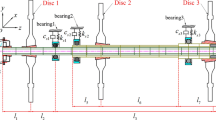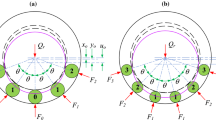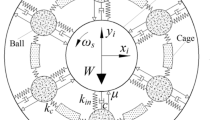Abstract
Time-varying stiffness is one of the most important dynamic characteristics of rolling element bearings. The method of analyzing the elements in the bearing stiffness matrix is usually adopted to investigate the characteristics of bearing stiffness. Linear mapping structure of the bearing stiffness matrix is helpful to understand the varying compliance excitation and its influence on vibration transmission. In this study, a method to analyze the mapping structure of bearing stiffness matrix is proposed based on the singular value decomposition of block matrices in the stiffness matrix. Not only does this method have the advantages of coordinate transformation independence and unit independence, but also the analysis procedure involved is geometrically intuitive. The time-varying stiffness matrix of double-row tapered bearing is calculated and analyzed using the proposed method under two representative load cases. The principal stiffnesses and principal axes defined in the method together indicate the dominant and insignificant stiffness properties with the corresponding directions, and the vibration transmission properties are also revealed. Besides, the coupling behaviors between different shaft motions are found during the analysis of mapping structure. The mechanism of the generation of varying compliance excitation is also revealed.

摘要
时变刚度是滚动轴承最重要的动态特性之一. 学者通常采用分析轴承刚度矩阵中的元素的方法来研究轴承的刚度特性. 轴承刚度矩阵的线性映射结构有助于理解变柔度激励及其对振动传递的影响. 基于刚度矩阵中块矩阵的奇异值分解, 本研究提出了一种分析轴承刚度矩阵映射结构的方法. 该方法不仅具有坐标变换无关性和单位无关性的优点, 而且所涉及的分析过程具有几何直观性. 本文采用该方法计算并分析了在两种典型载荷工况下的双列圆锥轴承的时变刚度矩阵. 该方法定义的主刚度和刚度主轴共同显示出了刚度的方向特性和主次特征, 并依此揭示出了滚动轴承的振动传递特性. 此外, 在映射结构分析过程中发现了内圈的不同运动之间的耦合行为. 还揭示了产生滚动轴承产生变柔度激励的机理.
Similar content being viewed by others
References
T. C. Lim, and R. Singh, Vibration transmission through rolling element bearings. part I: Bearing stiffness formulation, J. Sound Vib. 139, 179 (1990).
T. C. Lim, and R. Singh, Vibration transmission through rolling element bearings. part II: System studies, J. Sound Vib. 139, 201 (1990).
T. C. Lim, and R. Singh, Vibration transmission through rolling element bearings. Part III: Geared rotor system studies, J. Sound Vib. 151, 31 (1991).
C. S. Sunnersjö, Varying compliance vibrations of rolling bearings, J. Sound Vib. 58, 363 (1978).
H. V. Liew, and T. C. Lim, Analysis of time-varying rolling element bearing characteristics, J. Sound Vib. 283, 1163 (2005).
D. Petersen, C. Howard, N. Sawalhi, A. Moazen Ahmadi, and S. Singh, Analysis of bearing stiffness variations, contact forces and vibrations in radially loaded double row rolling element bearings with raceway defects, Mech. Syst. Signal Process. 50–51, 139 (2015).
G. Liu, J. Hong, and R. G. Parker, Influence of simultaneous time-varying bearing and tooth mesh stiffness fluctuations on spur gear pair vibration, Nonlinear Dyn. 97, 1403 (2019).
J. M. de Mul, J. M. Vree, and D. A. Maas, Equilibrium and associated load distribution in ball and roller bearings loaded in five degrees of freedom while neglecting friction. Part I: General theory and application to ball bearings, J. Tribol. 111, 142 (1989).
J. M. de Mul, J. M. Vree, and D. A. Maas, Equilibrium and associated load distribution in ball and roller bearings loaded in five degrees of freedom while neglecting friction. Part II: Application to roller bearings and experimental verification, J. Tribol. 111, 149 (1989).
B. Fang, K. Yan, J. Hong, and J. Zhang, A comprehensive study on the off-diagonal coupling elements in the stiffness matrix of the angular contact ball bearing and their influence on the dynamic characteristics of the rotor system, Mech. Mach. Theor. 158, 104251 (2021).
Y. Liu, and Y. Zhang, A research on the time-varying stiffness of the ball bearing considering the time-varying number of laden balls and load distribution, Proc. Inst. Mech. Eng. Part C-J. Mech. Eng. Sci. 233, 4381 (2019).
A. Rosyid, B. El-Khasawneh, and A. Alazzam, Review article: Performance measures of parallel kinematics manipulators, Mech. Sci. 11, 49 (2020).
G. Carbone, and M. Ceccarelli, Comparison of indices for stiffness performance evaluation, Front. Mech. Eng. China 5, 270 (2010).
B. S. El-Khasawneh, and P. M. Ferreira, Computation of stiffness and stiffness bounds for parallel link manipulators, Int. J. Mach. Tools Manuf. 39, 321 (1999).
A. Raoofian, A. Taghvaeipour, and A. K. E., On the stiffness analysis of robotic manipulators and calculation of stiffness indices, Mech. Mach. Theor. 130, 382 (2018).
V. C. Tong, and S. W. Hong, The effect of angular misalignment on the stiffness characteristics of tapered roller bearings, Proc. Inst. Mech. Eng. Part C-J. Mech. Eng. Sci. 231, 712 (2016).
Y. Guo, and R. G. Parker, Stiffness matrix calculation of rolling element bearings using a finite element/contact mechanics model, Mech. Mach. Theor. 51, 32 (2012).
Acknowledgements
This work was supported by the Joint Funds of the National Natural Science Foundation of China (Grant No. U1834202).
Author information
Authors and Affiliations
Corresponding author
Additional information
Author contributions
Di Yang developed the methodology, created the programming, conducted the data analysis and visualization, and wrote the original draft of the manuscript. Xi Wang proposed the conceptualization, supervised the entire research, reviewed and edited the final version of the manuscript.
Electronic Supplementary Material
Rights and permissions
About this article
Cite this article
Yang, D., Wang, X. Time-varying stiffness analysis of double-row tapered roller bearing based on the mapping structure of bearing stiffness matrix. Acta Mech. Sin. 38, 522030 (2022). https://doi.org/10.1007/s10409-022-22030-x
Received:
Accepted:
Published:
DOI: https://doi.org/10.1007/s10409-022-22030-x




